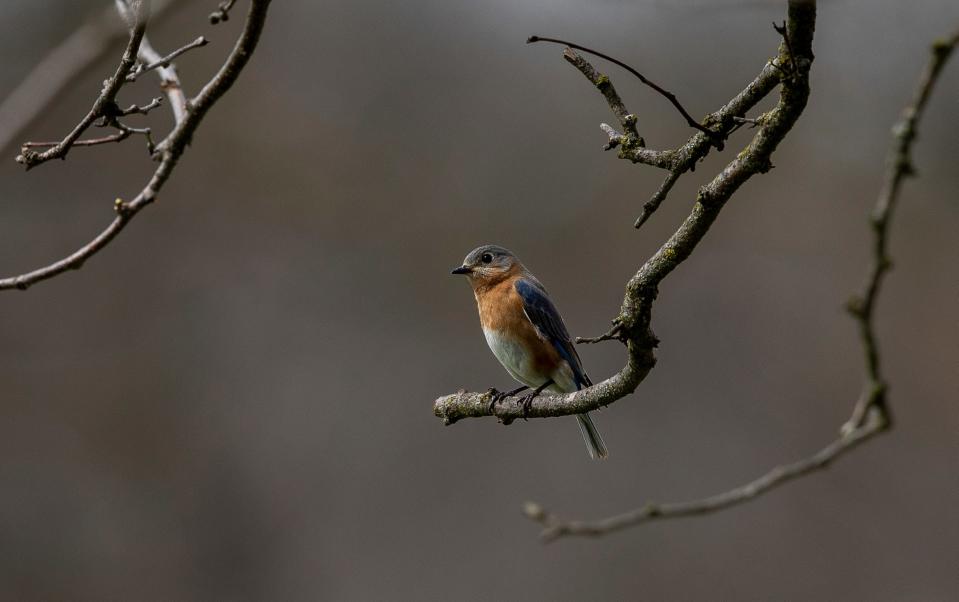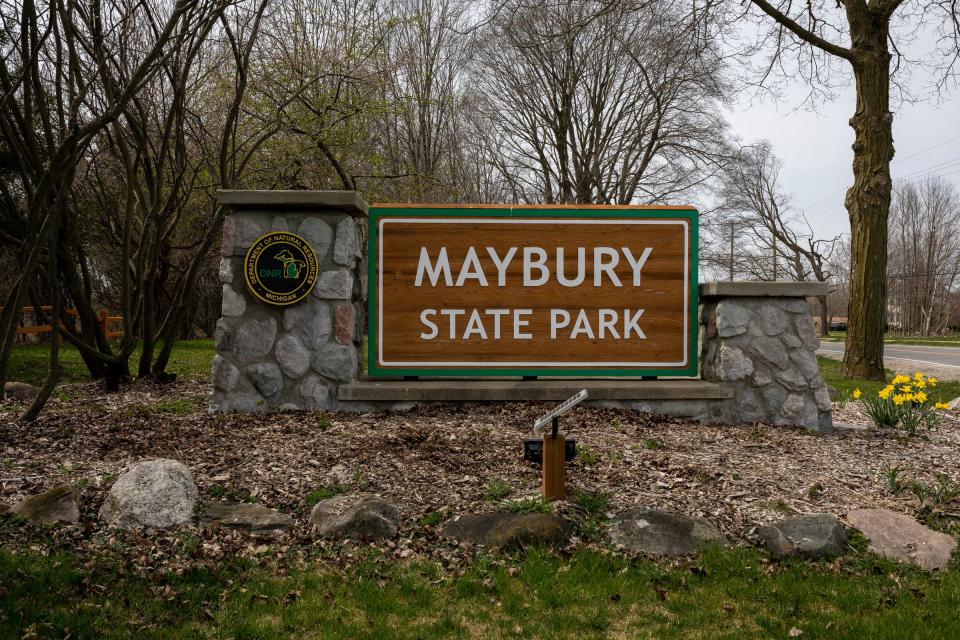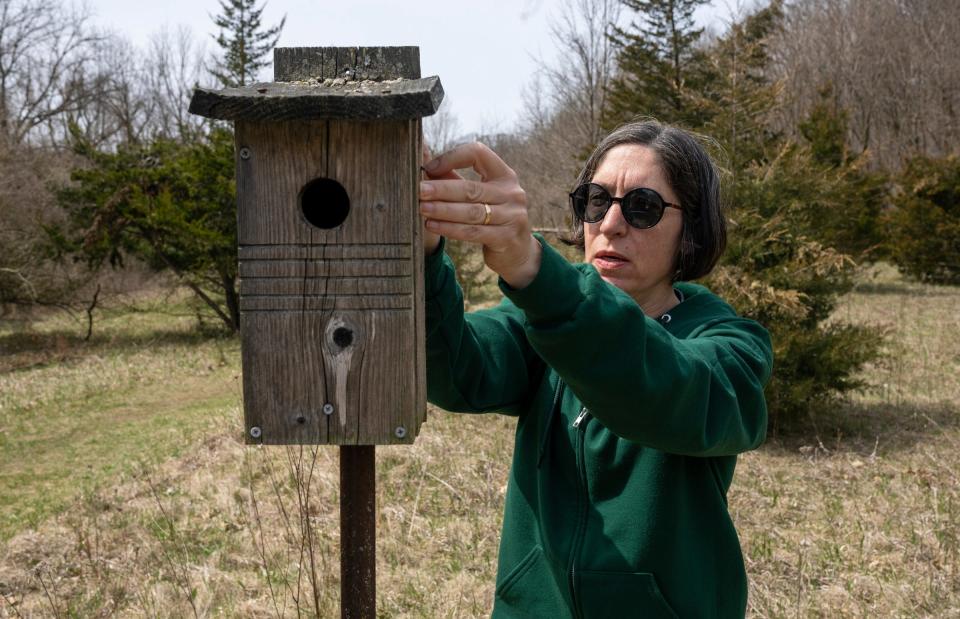It's nesting season for Eastern Bluebirds and good time to spot that flash of blue in sky
Eastern Bluebirds are not really blue — it's the way light waves interact with their feathers. But they are a part of Michigan's natural heritage and now that it's nesting season, they can be spotted as a flash of blue flying across the sky above a meadow, old field, or golf course, or simply perched atop a nesting box.
The birds are symbols of happiness and bring joy, according to folklore. One of the best places to spot them is Maybury State Park in Northville, where volunteers maintain 85 nesting boxes and monitor the condition of the nests, and the number of eggs and fledglings.
They're also watching for the impact of predators and harsh weather on the nests and birds.

Bluebirds need a cavity for nesting, such as rotted holes in trees. But they don't like to be in the woods, where many of these natural cavities can be found, and prefer to be out in the open — areas with short vegetation, and perches from which they can spot their prey, usually insects but they also eat berries and their larger prey includes shrews, salamanders, snakes, lizards, and tree frogs.
"They have to find cavities that are hard to find," said Kurt Hagemeister, president of the Michigan Bluebird Society, a statewide nonprofit education and conservation group focused on protecting bluebirds and their habitat.
Sign of spring: First Purple Martins spotted in Michigan for breeding season
Birds nearly wiped out
According to Hagemeister, the Eastern Bluebird was the first sign of spring for Michigan's early settlers. But in the mid-20th Century, its numbers plummeted and the birds disappeared completely from some parts of the state, victims of habitat loss, chemicals, global warming, and invasive species like the European starling and the house sparrow.
Some of the same forces, such as invasive plant species and chemicals, also caused a decline in insect populations that are part of the bluebird's diet.
As for the sparrows, the male will kill young bluebirds eat their eggs, and can sneak into a bluebird nesting box. They're not welcome, however, and their nests are removed from the boxes at Maybury.
With the addition of nesting boxes in neighborhood backyards and parks, Eastern Bluebirds now nest in all 83 counties in Michigan, Hagemeister said. An increase in cavities from the Emerald Ash Borer may have contributed to the population growth in southern Michigan, according to the state Department of Natural Resources.
Unraveling the winter: Spring habits of Michigan robins
A big comeback
Some of the best places to spot them are at several Huron-Clinton Metroparks: Oakwoods in New Boston, Lower Huron in Belleville, and Hudson Mills in Dexter, along with Island Lake State Park near Brighton, according to Hagenmeister. The Michigan DNR recommends the Fort Custer Recreation Area in Augusta, Ionia State Recreation Area in Ionia, Seven Lakes State Park in Holly, the Waterloo Recreation Area in Chelsea, and the Pickney Recreation Area in Pickney.

Then there's Maybury State Park, with its meadow ringed with trees, and its 85 nesting boxes across the park in Wayne County. The park started adding predator guards to the boxes in 2014 and the number of fledgings has increased, 20 in 2011 to 45 in 2022 and 54 in 2023.
But there are still hurdles — predators, harsh temperatures, and competition, said Kate Rayner, who has been bluebird box coordinator for the Friends of Maybury, which maintains the boxes, since 2016.
It's all in the boxes
The Friends of Maybury started monitoring the bluebird boxes in 1996 when there were already boxes in the park, built by scout and school groups. Initially, the the monitoring results were turned into the park office, now they go to the Michigan Bluebird Society.
Rayner said boxes are constantly being decommissioned and moved as they are overgrown, or replaced as they age.
Rayner said just one-fourth of the boxes house a bluebird, and half their nests are unsuccessful, victims of predators like sparrows, snakes and raccoons. The Friends of Maybury has eight volunteers who check their 10 or so boxes once a week. Tree swallows and Black-capped chickadees will also nest in the boxes.

Volunteer Janet Urbanski is in her second year of monitoring the boxes, and her third year of volunteering with the Friends of Maybury.
"I enjoy being a monitor because it's fun watching the birds develop from eggs into fledglings and rewarding to think I helped in the process," she said in an email.
"Maybury State Park is a very special place. The community is very fortunate that the land was saved from development and turned into a park when the sanitorium closed," she said referring to the city-within-a-city where patients were treated for TB. The sanitorium had some 40 buildings, could generate power and grow most of its food.
"I learned how to cross-country ski here in the early 1980s and when I moved back to the area three years ago and was looking for a way to serve my community, I joined the Friends of Maybury," Urbanski said.
While the park has a year-round population, the bluebirds are easier to spot when they are nesting in spring and early summer, flying back and forth from the boxes just hanging out around the nest, or darting toward the ground for a bug.
Rayner said a park ranger told her that this year there are now more bluebirds than ever.
Want to spot a bluebird yourself?
Sit and wait anywhere near a box and Rayner said, "chances are you'll see one." Rayner said your best bet is to look in a field with multiple boxes. "Odds are most of the boxes will have a tree swallow or another bird, but if one watches a field that has boxes in it, you increase the chances of seeing a bird," she said.
Look for that flash of blue in the sky.
Contact Jennifer Dixon: jbdixon@freepress.com
This article originally appeared on Detroit Free Press: It's nesting season for Eastern Bluebirds. How to spot one in Michigan

